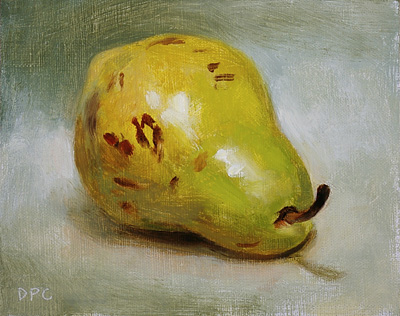
12/5: Bartlett pear #3, oil on linen panel, 4x5 in. SOLD
I've been letting down the two or three people who care, by not mentioning how long some of these pieces have taken. This one was about 45 minutes. (I think the one before was more like an hour and a half.) The yellows and greens of these pears are annoyingly much more vivid than I can paint, but I hope I've been getting some sense of them. To me this one is a little better, as I think I'm getting back some of my own vividness and clarity of color which had been a little more tepid lately.
Old English word of the day:
pere [pĕr'-ə]: pear.
(perewós: perry, a cider-like drink made from pears; literally "pear moisture/juice.")
From a history of pears and perry in the UK, by Gillian Grafton:
Tacitus implies in some of his writings that pears were cultivated in Britain at the time of the Roman occupation. Charlemagne (circa 800) issued a list of plants to be cultivated which included pears. In Britain however, definite records are not available until after the Norman Conquest. The Domesday Book of 1086 mentions old pear trees several times as boundary markers, implying their cultivation before this period.
Court accounts in the reign of Henry III (1207-72) show that pears were imported from France and for many years French varieties dominated English orchards. Pears were imported from the La Rochelle area of France which was famed for its pears.
Eleanor of Provence, wife of Henry III, developed extensive orchards and there is a record in 1262 of the court gardener planting six Cailhou (Cailloel) pear trees. Eleanor of Castille, wife of Edward I, was a keen gardener. In the court accounts for 1276-92 the following pear types were noted: Kaylewell (Calswel); Rewel (de Regula); and Pesse-Pucelle. Kaylewell was a synonym for the Caillou and was seen as a pear fit only for baking but was very popular with the royal family at the time. Other pear varieties noted at this time were: Martins; Dreyes; Sorells; Gold-Knopes; Regul; and Chyrfall.
Sometime before 1388 the first important English pear variety, the Wardon, was introduced by Cistercian Monks at Wardon in Bedfordshire. It was widely used for pies, which became known
as Wardon pies.



No comments:
Post a Comment